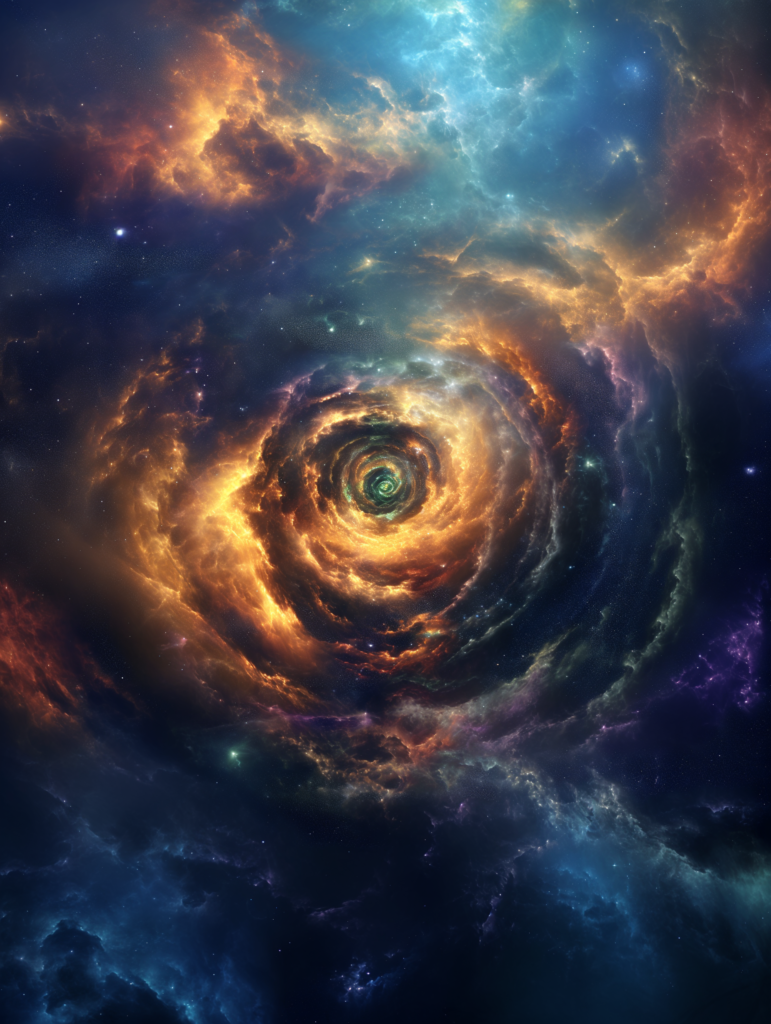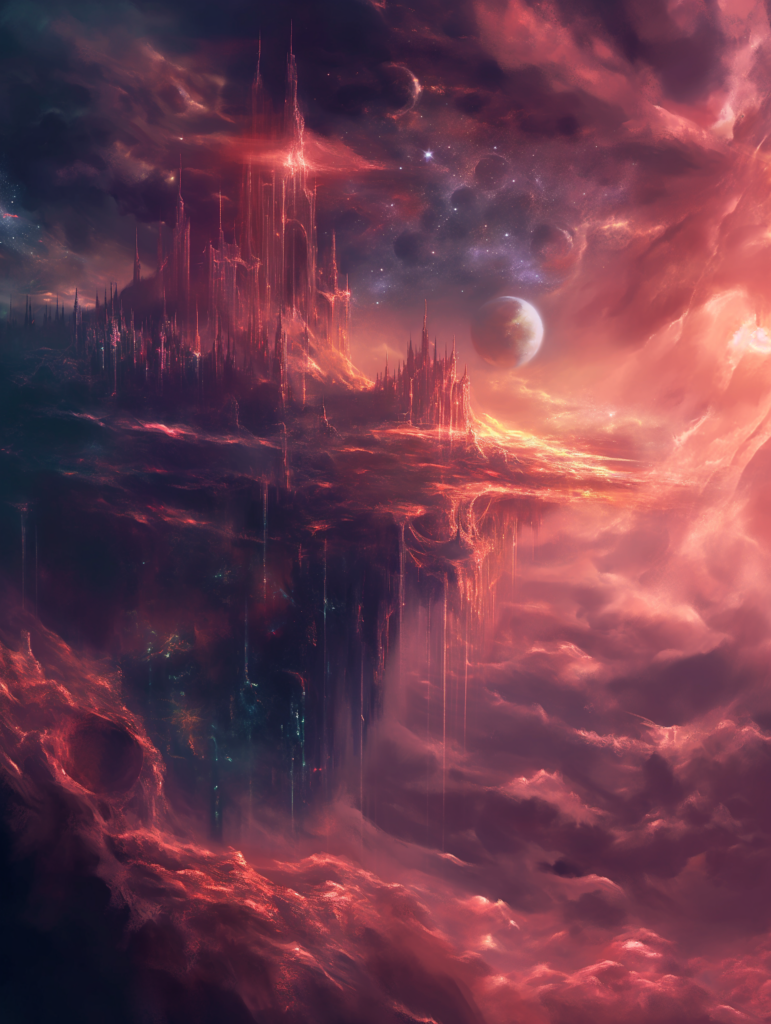The Multiverse

The multiverse unfolds as an intricate tapestry of cosmic wonders, stretching infinitely in all directions. Each thread of reality, a plane unto itself, weaves a unique story into the fabric of existence. Brilliant nebulas and astral currents form the celestial backdrop, a celestial canvas painted with the hues of magic and mystery.
Planar realms manifest as vast landscapes suspended in the cosmic void, each with its defining characteristics. Elemental planes blaze with primordial fires, breathe with gusts of pure air, ripple with undulating water, and echo with the solid echoes of earth. Outer planes, each a metaphysical realm of moral and ethical essence, radiate with ethereal light or plunge into shadowed depths.
In the vast expanse of the multiverse, astral rivers flow, connecting planes and creating pathways for interplanar travel. These rivers, shimmering with the essence of magic, carve ethereal channels through the astral sea, allowing intrepid explorers to navigate the boundless cosmos.
Clusters of demiplanes, miniature realities birthed by powerful beings or arcane forces, hang like jewels in the cosmic tapestry. Each demiplane, a pocket of existence with its peculiar rules, may harbor hidden treasures, ancient mysteries, or the lingering echoes of long-forgotten events.
Celestial bodies, remnants of forgotten epochs, drift through the multiverse. Some bear the scars of cosmic battles, while others shine with the radiance of unexplored potential. Shards of reality dance in the astral winds, coalescing into new planes or fragmenting into ephemeral realms.
Throughout the multiverse, echoes of powerful entities resonate, shaping the fate of planes and influencing the flow of time. Cosmic beings, embodiments of fundamental forces, preside over their domains, casting their influence across the tapestry of reality.
Traveling between planes reveals a kaleidoscope of environments, from crystalline citadels floating in the void to cavernous abysses echoing with the tormented cries of lost souls. The atmosphere shifts seamlessly, reflecting the essence of each plane—be it the harmonious melodies of Elysium or the eerie stillness of the Ethereal Plane.
Thus, the multiverse unfolds, an ever-expanding canvas of realms, mysteries, and magic, inviting intrepid adventurers to navigate its cosmic expanse and discover the secrets hidden within its celestial threads.
What is the Multiverse

The concept of the multiverse refers to a complex and interconnected web of alternate dimensions, planes, and realities that coexist alongside each other. These diverse realms are often governed by distinct laws of magic, unique physical properties, and populated by fantastical creatures, providing a rich tapestry for players and storytellers to explore. Here’s how the multiverse is often conceptualized in such games:
- Planar Structure: The multiverse is composed of different planes, each representing a distinct aspect of existence. These planes include elemental realms, outer planes aligned with specific moral or ethical principles, and demiplanes with their own peculiar rules.
- Interplanar Travel: Characters within the game can traverse these planes through various means, such as portals, magic spells, or powerful artifacts. This allows for adventures that span across different dimensions, where heroes may face diverse challenges and encounter beings not bound by the laws of the material world.
- Parallel Realities: Some games introduce the concept of parallel realities or alternate timelines, where choices made by characters or pivotal events diverge, leading to the creation of separate realities. Exploring these alternate worlds can reveal both familiar and radically different landscapes, civilizations, and adversaries.
- Cosmic Entities: The multiverse is often overseen by powerful cosmic entities or deities, each associated with different aspects of existence. These beings may manipulate the fabric of reality, influence events across multiple planes, or act as patrons to adventurers.
- Magic and Artifacts: Magical items, artifacts, or ancient relics within the game world may have the ability to open portals to other planes or tap into the energies of the multiverse. These items can serve as key plot elements or sources of great power for characters.
- Alignment and Ethical Dimensions: Different planes are often aligned with specific moral or ethical alignments, creating a moral compass for the multiverse. Characters may navigate through planes that embody concepts such as good, evil, law, chaos, or neutrality.
- Quests and Challenges: Adventures within the multiverse may involve quests that span multiple planes, requiring characters to navigate through diverse environments, solve puzzles tied to the nature of each plane, and confront powerful foes from different dimensions.
Overall, the multiverse in these games offers a vast and dynamic backdrop for storytelling, enabling players to explore a myriad of environments, face extraordinary challenges, and interact with a diverse array of magical and otherworldly elements. It adds depth, complexity, and endless possibilities to the game world, fostering creativity and imagination.
The Multiverse in popular culture
The multiverse is a theoretical concept that originates from physics, cosmology, and speculative fiction, depicting a vast and diverse collection of universes or realities that exist simultaneously. The idea of a multiverse has been explored in various scientific theories, philosophical discussions, and fictional works, each providing a unique interpretation of its nature.
In physics and cosmology:
- Quantum Mechanics: In the realm of quantum mechanics, the multiverse hypothesis arises from the interpretation of quantum superposition and probability. According to some interpretations, every quantum event that has multiple possible outcomes results in the creation of multiple universes, each realizing one of the potential outcomes.
- Cosmological Models: Certain cosmological models, such as inflationary cosmology, suggest that our observable universe is just one of many regions within a much larger multiverse. These regions can have different physical constants, laws of physics, or even dimensions.
In speculative fiction and popular culture:
- Alternate Realities: The multiverse concept is widely embraced in science fiction and fantasy. Stories often depict parallel universes or alternate realities that coexist with our own but may have different histories, characters, or laws of nature.
- Comic Books and Superheroes: Many comic book universes, particularly in superhero genres, feature multiverses where different versions of characters and storylines unfold. Iconic examples include DC Comics’ “Multiverse” and Marvel Comics’ “Multiverse” or “The Omniverse.”
- Multiverse in Literature: Authors like Michael Moorcock, Philip K. Dick, and Stephen King have explored multiverse themes in their works. Moorcock’s “Eternal Champion” series, Dick’s “The Man in the High Castle,” and King’s “The Dark Tower” series are examples.
- Interdimensional Travel: Some stories involve characters moving between different dimensions or realities within a multiverse. This can lead to encounters with alternate versions of themselves, historical events, or fantastical landscapes.
While the concept of the multiverse remains speculative and lacks empirical evidence in the realm of physics, it continues to captivate the imagination of scientists, philosophers, and storytellers alike. Whether a scientific hypothesis or a narrative device, the multiverse concept provides a fascinating lens through which to explore the infinite possibilities and mysteries of existence.

 Buy me a coffee
Buy me a coffee